LayeredLayouts is a package for working out how to layout graphs in a layered fashion. In particular for how to layout directed acyclic graphs (DAGs), including trees, dependency graphs, and sankey diagrams. It is not a package for actually visualizing graphs, rather it is a suitable helper for those to use. It is a lot like NetworkLayout.jl.
Presently it has one algorithm:
Zarate, based on
D. C. Zarate, P. L. Bodic, T. Dwyer, G. Gange and P. Stuckey, "Optimal Sankey Diagrams Via Integer Programming," 2018 IEEE Pacific Visualization Symposium (PacificVis), Kobe, 2018, pp. 135-139, doi: 10.1109/PacificVis.2018.00025..
Which is a Sugiyama style layout algorthm via full mixed integer programming.
Starting from v0.2 LayeredLayouts.jl switches from LightGraphs.jl to Graphs.jl for graph representation. See this discourse post for more information. If you want to use LightGraphs.jl please specifically ] add LayeredLayouts@0.1
julia> using LayeredLayouts, Graphs
julia> tiny_depgraph = SimpleDiGraph(Edge.([
1 => 2;
2 .=> [4, 5, 6];
3 .=> [2, 4, 5, 6, 7, 8];
4 .=> [9, 10, 11];
]))
{11, 13} directed simple Int64 graph
julia> xs, ys, paths = solve_positions(Zarate(), tiny_depgraph);
julia> xs, ys
([1.0, 2.0, 1.0, 3.0, 3.0, 3.0, 2.0, 2.0, 4.0, 4.0, 4.0], [-0.500000683006983, -0.9285709647225431, 0.500000681452564, 0.40476260792712027, -0.5952375840605986, -1.5952379163280372, 3.0714291353124143, 2.0714290900138614, 1.404762745121713, 0.4047626078228009, -0.5952375294761111])
julia> paths
Dict{Graphs.SimpleGraphs.SimpleEdge{Int64},Tuple{Array{Float64,1},Array{Float64,1}}} with 13 entries:
Edge 2 => 5 => ([2.0, 3.0], [-0.928571, -0.595238])
Edge 3 => 8 => ([1.0, 2.0], [0.500001, 2.07143])
Edge 3 => 5 => ([1.0, 2.0, 3.0], [0.500001, 0.0714291, -0.595238])
Edge 4 => 11 => ([3.0, 4.0], [0.404763, -0.595238])
Edge 3 => 2 => ([1.0, 2.0], [0.500001, -0.928571])
Edge 4 => 10 => ([3.0, 4.0], [0.404763, 0.404763])
Edge 3 => 4 => ([1.0, 2.0, 3.0], [0.500001, 1.07143, 0.404763])
Edge 3 => 7 => ([1.0, 2.0], [0.500001, 3.07143])
Edge 2 => 4 => ([2.0, 3.0], [-0.928571, 0.404763])
Edge 1 => 2 => ([1.0, 2.0], [-0.500001, -0.928571])
Edge 2 => 6 => ([2.0, 3.0], [-0.928571, -1.59524])
Edge 3 => 6 => ([1.0, 2.0, 3.0], [0.500001, -1.92857, -1.59524])
Edge 4 => 9 => ([3.0, 4.0], [0.404763, 1.40476])This plots are from the examples in test/examples.jl, plotted via script in test/demos.jl.
As you can see in the first plot below, pathing though the dummy nodes actually guarantees minimal number of crossings. On the tiny_depgaph example direct has 3 crossings, where as path through dummy node only 2). However, it also doesn't actually always look as nice. It might look nicer if you used some swishy Bezier curves though (Plots.jl has a curves attribute, and a matching function, which does this) We leave that to the visualization library.
| Direct | Path though dummy nodes |
|---|---|
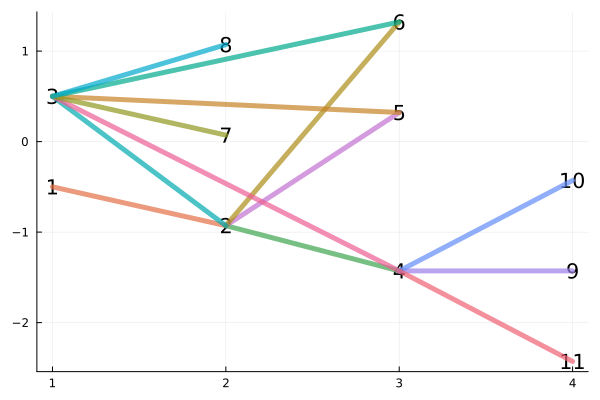 |
 |
 |
 |
 |
 |
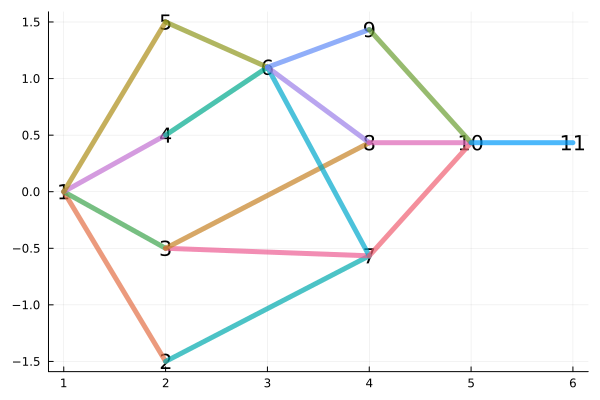 |
 |
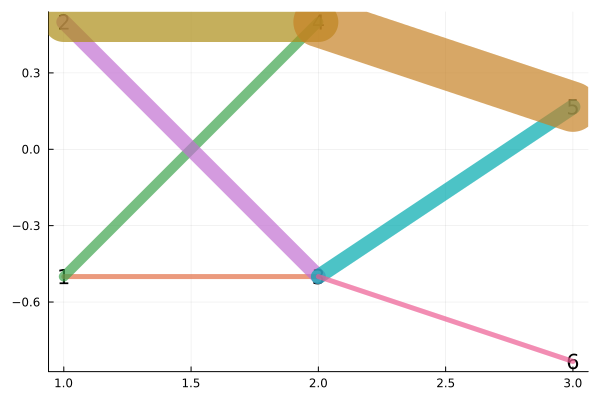 |
 |
 |
 |
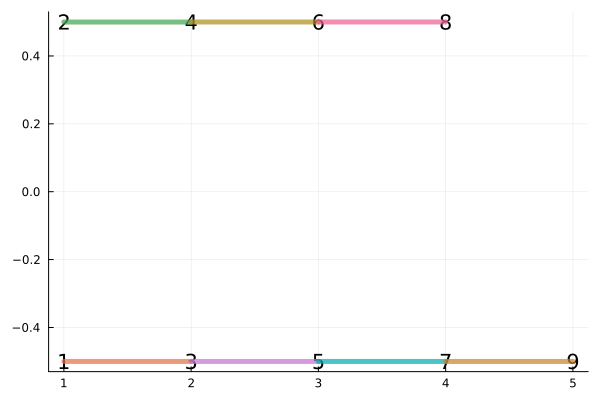 |
 |
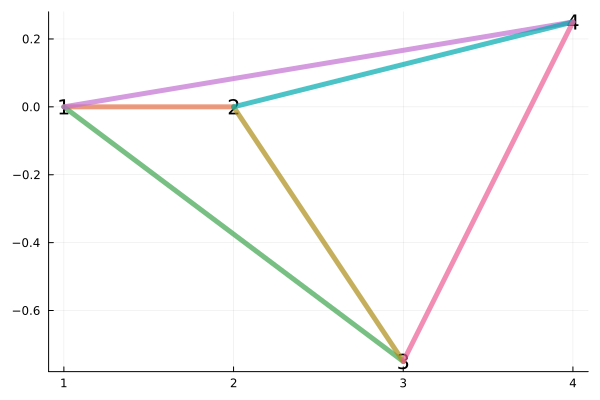 |
 |